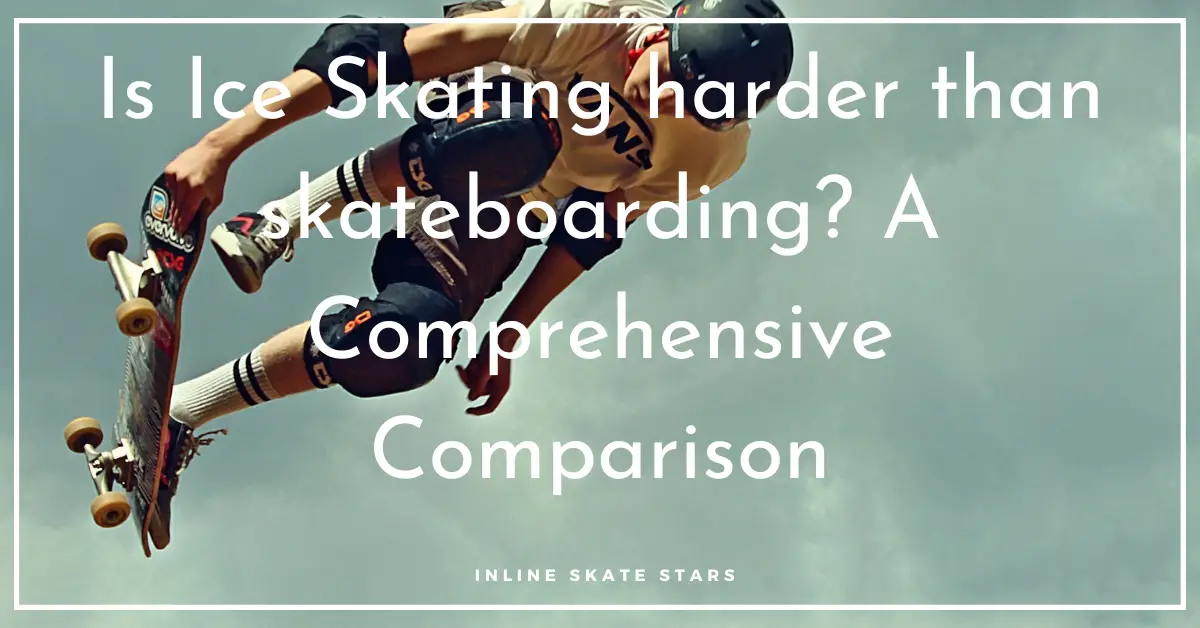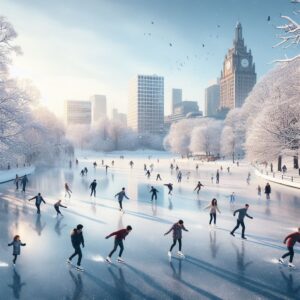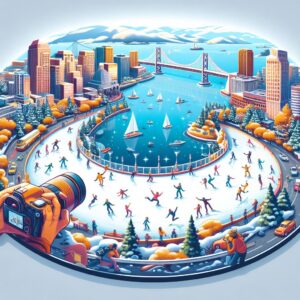Is ice skating harder than skateboarding?
Skateboarding and ice skating are two popular recreational activities that many people enjoy.
They have a lot of similarities but also have some key differences.
I will compare the two in this blog post to see which is harder. So, let’s get to it!
Is Ice Skating Harder Than Skateboarding?
Is ice skating harder than skateboarding? Ice skating isn’t as hard as skateboarding since you completely control your feet using ice skates.
On the contrary, in skateboarding, your feet rest on a skateboard, which can be pretty hard to control for beginners.
Below I elaborate on why ice skating is a lot easier than skateboarding!
Balance and Coordination
Skateboarding requires a lot of balance and coordination since your feet only rest on a board.
Ice skaters also need good balance but have more control over their speed and direction as they glide across the ice.
This is because ice skates can be worn.
Propulsion and Skating Fast
Propulsion and skating fast on skateboards are challenging unless you’re going downhill.
Skateboarders use their feet and legs to push against the ground to move quickly.
This is not the case with ice skating, where skaters glide across the surface using their skates.
Performing Tricks
Performing tricking on skateboards can be pretty difficult. Skaters must use their balance, coordination, and power to perform different tricks.
Ice skaters don’t have this problem since they glide across the surface using their skates.
Examples of skateboarding tricks include the ollie, while Backward stroking and the Bunny hop are examples of figure skating tricks for beginners.
Time Taken to Learn the Basics
It can take a long time to learn the basics of skateboarding.
This is because you need balance and coordination to do different tricks.
It usually takes about one year to learn skateboarding and be comfortable on a skateboard, but it takes about three years to perfect the skill.
On the contrary, ice skating basics can be learned in just a few weeks–about three months if you take only one weekly session.
Braking Techniques
Skateboarding requires good braking techniques to stop before you hit something.
Skaters use their feet and boards to brake and turn.
Ice skaters have many ways to stop, including the hockey stop, T-stop, and snowplow stop.
Beginners can pick either option and master it. This is unlike skateboarding, where there aren’t so many options.
Read more about how to stop when ice skating in this complete guide.
Ice Skating vs. Skateboarding | Other Elements of Comparison
Below are more elements of comparison between ice skating and skateboarding besides hardness. Keep reading!
Calories Burned
Due to the different speeds and movements of skating and skateboarding, these activities burn different calories.
Ice skating generally burns more calories than skateboarding.
Skateboarding burns about 400 calories an hour, while ice skating burns about 640-850 calories per hour.
Skating Gear and Equipment
Skating gear and equipment are essential to skating.
It includes ice skates for ice skating, a board for skateboarding, a helmet, clothes (to keep you warm), elbow pads, wrist guards, and gloves.
Skateboarders also need appropriate shoes for skateboarding.
Skating Surfaces
Ice skating is done on icy surfaces. This can be on a frozen lake, pond, river, or an artificial rink like a hockey rink.
On the other hand, skateboarding is done on dry surfaces like concrete, wood, and asphalt.
Muscles Involved
Ice skating and skateboarding use similar muscles.
Owing to the nature of the sports, ice skating and skateboarding use all muscles in the body, especially the lower body.
The primary muscles in this area include the core, glutes, quads, and hamstrings.
Risks of Injury
Ice skating and skateboarding both involve risks of injury.
Skaters can fall, hit their heads on the ice, or sustain a skateboard accident.
Injuries from skating include sprains, strains, contusions (bruises), torn muscles and ligaments, fractures (broken bones), concussions (brain injuries), and amputations.
Health Benefits
Both ice skating and skateboarding have health benefits.
Skaters can increase their mobility, improve balance and coordination, reduce stress levels, burn calories, build muscle, and strengthen bones by indulging in ice skating or skateboarding.
How To Learn Skateboarding Fast
Here are some actionable tips on how to learn skateboarding fast!
Begin With The Basics
Skateboarding can be a lot harder than ice skating and takes much more practice to get good at.
If you are starting, it is best to begin with, skateboarding basics.
This will help you learn how to balance, control your speed and move around on the board efficiently.
Once you have learned the basics, it’s time to move on to more advanced tricks and techniques.
Mastering different skateboarding techniques will make you a better skater overall and enable you to do some amazing stunts!
Learn How to Fall
Falling is a part of skateboarding, and it’s essential to learn how to do it correctly.
Always use both hands to maintain balance and not land too hard on your back or head when skating.
If you fall, stay calm and get up quickly, so you don’t injure yourself further.
Try not to dwell on the fall – focus on getting back onto the board as soon as possible!
Gradually Build up Tricks
Skateboarding can be much more fun and exciting if you gradually learn beginner tricks.
Begin with basic skateboarding maneuvers like The Kick Turn, Drop-Ins, and The Tic-Tac.
Once you have mastered these skills, it’s time to add more complex stunts.
This way, you don’t feel rushed or stressed when trying them out for the first time.
Practice more Often
Skating can be practiced as often as you like, but it’s always important to practice safely.
Start with easier tricks and gradually work your way up, so you don’t injure yourself.
Be sure to enjoy skateboarding – if you do, practicing will become much less of a chore!
Get a High-Quality Skateboard
A good skateboard will make a big difference in your skating experience.
A quality skateboard will feel smooth under your feet and provide adequate support.
Don’t skimp on this purchase – investing in a good skateboard is one of the best investments you can make!
Consider the dimensions, weight, and brand when shopping for a board.
Get the Recommended Shoes for Skateboarding
Shoes are essential to skateboarding, and getting the right type for your feet is critical.
Check the size chart before buying to ensure you buy a half-size larger than your regular shoe size.
Here are some of the best shoes to consider.
Wear Protective Gear
It is essential to wear protective gear like a helmet, elbow and knee pads, and skateboard gloves when skating.
These items will help keep you safe while skateboarding and can save your skin in the event of an accident.
Find the Right Location for Skating
When skating, it is essential to choose a skatepark that is appropriately designed for skating.
Many skateparks are poorly built and can cause injuries.
Make sure to find out about the park layout before you go skating to know which tricks to try and where it will be safe to do them.
Skate With Others
Skating with others can make the experience even more fun.
Skating with friends is a great way to learn new tricks and have some laughs.
When skating with others, be sure to communicate and stay safe together!
Record Yourself
Taking videos and photos of your skating can be a fun way to document your progress.
When skating well, take a moment to film yourself for posterity.
Not only will this help you keep track of your progress, but it can also give other skaters ideas about tricks they might want to try.
Find Helpful Information on the Web
Many skaters have found skating tips and advice on the web.
Skaters often post helpful videos, blog articles, and photos online that can help you improve your skateboarding skills.
Google “skateboarding tips” or “skater safety” to find some good resources.
Consider Lessons
If skateboarding is new to you, consider taking lessons from a pro skater.
Lessons can help you learn the proper techniques and improve your skating skills quickly.
How to Learn Ice Skating Fast
Below are actionable tips for how to learn ice skating fast.
Get Top-quality Ice Skates
If you’re thinking of taking up ice skating as a hobby or want to improve your skills for fun, there are a few things you need to do first.
Getting good skates is the most crucial part – they must be comfortable and fit properly so you can skate easily.
Depending on your preferred ice skating discipline, you should also get appropriate ice skates.
This can be a speed skate, figure skate, ice hockey skate, or recreation skate. Here are some top-quality ice skates to consider.
Don’t Look Down
When skating, it’s essential to keep your head up and look around.
Looking down can lead to dangerous falls. Watch where you’re going and be aware of obstacles in your path.
Tie Skates Appropriately
Tying skates the right way can prevent them from coming off your feet.
It’s essential to tie skates at a tightness that allows you to move easily in them but still keep them on your feet when skating.
There are two types of skate ties: boot ties and lace-ups.
Boot ties are easier to untie if you need to take them off quickly, but lace-ups offer more security.
Warm Up and Down Before and After Sessions
Before skating, warm up your muscles by skating at a slow speed for 10 minutes.
This will help reduce the risk of severe injuries and improve your skating skills.
After skate sessions, take some time to cool down – ice skaters often take long stretches on the ice to restore their body’s heat.
Get some lessons
Getting some lessons is essential if you want to improve your ice skating skills fast.
Lessons can teach you the proper techniques and help you build a good foundation.
If this interests you, consider taking classes or learning from a pro skater.
Use the Recommended Skating Posture
When skating, use the recommended skating posture to manage your body weight.
This will help you skate with more control and improve your stability. When skating correctly, keep your back straight and your head up.
It would be best to look forward while skating to maintain a good balance.
Please don’t take it too seriously
Remember, ice skating is fun – don’t take it too seriously.
Protect yourself by wearing the proper gear, but don’t let injuries keep you from enjoying skating! If you fall, laugh it off and get back on the ice.
Check Online Tutorials on YouTube
If you’re looking to learn how to ice skate, there is no better way than through online tutorials.
YouTube is home to countless instructional videos that teach you the basics in minutes.
There are many different skating techniques and tips that you can learn from these resources – so don’t be afraid to explore them all!
Skating on ice requires patience and practice – start by watching some helpful online tutorials first.
Learn How to Brake
One of the most critical skills for ice skaters is how to brake.
When skating on ice, it’s essential to be able to stop quickly and smoothly.
You can use the three primary stopping techniques depending on your abilities. These are the T-stop, snowplow, and hockey stop.
Final Thoughts
Both ice skating and skateboarding are incredible hobbies.
But skateboarding is pretty harder to learn and master for some people. The good news is that with dedication and passion, you can pull it off.
Nothing should stop you if you desire to try ice skating or skateboarding. Find an ice skating rink or skatepark near you and get started today.
- More Reading>> Is Roller Skating Harder Than Skateboarding?
- Are Inline Skates Good Practice for Ice Skating?
- What is the Difference between Inline Skates and Rollerblades?
- Are Rollerblades Dangerous? Revealed!
- Do Roller Skates Need Spacers?
- How Much Do Roller Skates Cost?
- How to Make Roller Skates Faster
- How to Make Roller Skates Less Slippery
- 10 Health Benefits of Rollerblading | New Research
- Inline Skating Gear: The Must-Have Complete Gear for Skaters




